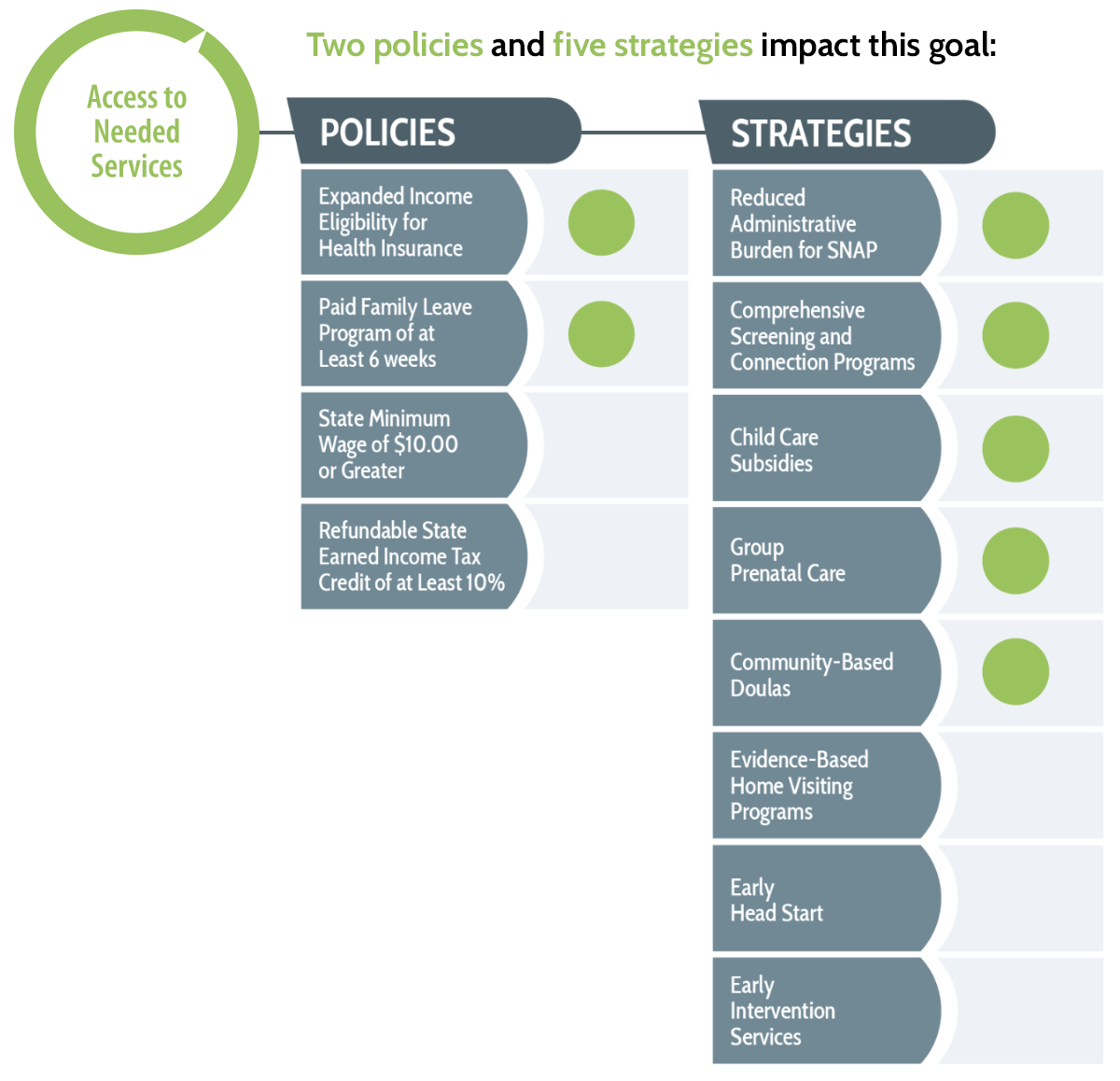
Effective policies and strategies to impact this goal include:
Families have access to necessary services through expanded eligibility, reduced administrative burden and fewer barriers to services, and identification of needs and connection to services.

WHY IS ACCESS TO NEEDED SERVICES AN IMPORTANT PRENATAL-TO-3 GOAL?
Ensuring access to the resources and services that parents and children need is foundational to building a prenatal-to-3 system of care. States provide a number of benefits and programs to children and families, based on varying eligibility criteria and modes of delivery. However, use of services among families who are eligible varies considerably from state to state: Between two children in different states with identical needs, one may receive a benefit that the other does not, a situation leaving many without the services that help them to thrive. Families of color, in particular, are less likely to receive services even though they are eligible, as demonstrated by research on programs such as Medicaid, WIC, and Early Intervention (EI) services.1,2 For example, in a study about EI services, eligible Black children at age 2 were found to be 5 to 8 times less likely to receive services than White children, depending on the eligibility category.3
States have the ability to increase families’ and children’s access to services through three primary pathways:
- Expanding eligibility criteria;
- Reducing administrative burden and barriers to services; and
- Screening for the specific needs that families and their children have and connecting them with the precise services they need.
Expanded Eligibility Criteria
States have the flexibility to determine who is eligible for many programs and services, including programs largely funded by the federal government. Determinations about who is eligible for a service can be driven by whether a state has adopted a specific policy (for example, paid family leave or expanded income eligibility for health insurance), the broad or narrow criteria the state uses to determine whether someone is eligible (for example, criteria for Early Intervention services or child care subsidies), or whether to include or exclude certain populations that are not automatically eligible (for example, some states use state funds to provide services to immigrant families and children). These decisions drive variation in whether two children or parents with similar needs, but in different states, receive similar help.
Fewer Barriers to Services and Reduced Administrative Burden
Families experience different levels of barriers accessing resources and care. For some families, barriers are low and accessing resources is often simple, but for other families, multiple barriers (e.g., lack of transportation or time, exclusivity, lack of support, high costs, etc.) may make it difficult to access resources and care needed to help their families thrive. States can make choices that ease the barriers individuals and families face in accessing resources and care, and in doing so, may also subsequently improve additional indicators of families’ wellbeing as a result of increased use of needed services and programs. For example, states can support innovative program models, such as group prenatal care models, that seek to improve the accessibility of care (e.g., through an alternative care model and the integration of peer support).
Administrative burden refers to the barriers that increase the costs—time, money, and psychological distress—of applying for and maintaining eligibility in a public assistance programs. Administrative burden policies come in many forms, such as requiring that recertification for benefits take place in person rather than remotely, or that recertification take place every 3 months rather than 12, or that a host of documents be presented to prove eligibility. Moreover, the policies can result from intentional or inadvertent features of regulations that states put in place.4 Regardless of the intentions, administrative burden policies are largely costly and inefficient, and they reduce the use of services among those who are eligible. Because state resources are generally scarce, reasonable policies are needed to ensure that only families who are eligible receive the intended services, but states have found methods to reduce fraud while also reducing unnecessary burdens on eligible families.
Screenings and Connections to Needed Services
Identifying needs early and addressing them immediately helps to reduce the need for later services (and saves money).5 An adequate system for screening and connections requires four components: (1) screening to identify the precise services that are needed, (2) referring and connecting the family to the needed services, (3) serving the family to address the need, and (4) monitoring outcomes to ensure the need is addressed. A breakdown in any of these links to services threatens the health of the system and may compromise improvements in outcomes. Our current systems often focus on screening, yet neglect to document the needs of the families, the services rendered, or the improvements made in family and child wellbeing.
Through our comprehensive reviews of rigorous research, we have identified policies and strategies that provide states with key opportunities to remove obstacles that prevent families from participating in the programs intended to help them thrive. Next is a closer look at these policies and strategies and an overview of important outcome measures that states should use to track their progress toward removing barriers to access.
HOW ARE STATES CURRENTLY MEETING THIS PRENATAL-TO-3 GOAL?
Four outcome measures illustrate families’ access to services based on expanded eligibility, fewer barriers to resources and care, reduced administrative burden, and screenings for needed services: (1) health insurance access among low-income women of childbearing age, (2) receipt of adequate prenatal care, (3) access to the Supplemental Nutrition Assistance Program (SNAP) among eligible households with children under age 18, and (4) developmental screenings among children under age 3. These outcomes vary considerably across states, as well as by race and ethnicity.
All four outcome measures were calculated intentionally in the negative direction to demonstrate where states have room for improvement and to help states prioritize the prenatal-to-3 policy goals. Out of 51 states, the state lagging furthest behind ranks 51st, and the leading state ranks first. The median state indicates that half of states have outcomes that measure better than that state, whereas half of states have outcomes that are worse. Importantly, the “leading” state on a given outcome does not necessarily indicate a target for all other states to strive toward; even in the states with the best outcomes, many children and families are struggling.
OUTCOME MEASURE: LACK OF HEALTH INSURANCE
% low-income women uninsured
Median state value: 16.4%
In the five lagging states, a third or more of low-income women of childbearing age do not have health insurance, leaving them physically and financially vulnerable, and without access to pre- or inter-conception care. Expanded income eligibility for health insurance would provide health insurance to most of these uninsured women, but not one of the five worst states has adopted the policy. At the extremes, low-income women in Texas are 46 times more likely than similar women in Vermont to lack health insurance, and lower-income Hispanic women lack health insurance at twice the rate of all other women.
Source: 2021 American Community Survey (ACS) 1-Year Public Use Microdata Sample (PUMS).
OUTCOME MEASURE: LACK OF ADEQUATE PRENATAL CARE
% births to women not receiving adequate prenatal care
Median state value: 13.8%
The receipt of adequate prenatal care is essential to support the health and wellbeing of birthing people, including healthy births. In the five leading states, less than 10% of women do not receive adequate prenatal care, compared to roughly 1 in 5 or more in the five lagging states. There are also racial disparities in the lack of adequate prenatal care: Black women are twice as likely to not receive adequate prenatal care compared to White women.
Source: National Center for Health Statistics (NCHS), final natality data 2020. Retrieved June 16, 2023, from www.marchofdimes.org/peristats. Variation by race and ethnicity data are NCHS final natality data averaged across 2019-2021 (retrieved August 12, 2022); N/A = Reported data for “Other” do not align with the race/ethnic categories presented throughout the Roadmap.
OUTCOME MEASURE: LACK OF ACCESS TO SNAP
% eligible units with children under age 18 not receiving SNAP
Median state value: 12.5%
SNAP is a vital resource for increasing families’ food security and improving nutrition. In the six leading states, more than 90% of units with children under age 18 who are eligible for SNAP receive the benefit. In the five lagging states, approximately 1 in 4 eligible units with children does not receive SNAP. SNAP receipt also reveals racial disparities: Among eligible units with children, 8.9% of Black units and 10.8% of White units do not receive the benefit, whereas 27.0% of Hispanic units go without.
Source: As of 2017-2019 (CPS-ASEC 2018-2020). Urban Institute’s TRIM3 project.
OUTCOME MEASURE: LACK OF DEVELOPMENTAL SCREENINGS
% children under age 3 not receiving developmental
Median state value: 57.9%
About 3 out of 4 children in the five lagging states do not receive a developmental screening assessment prior to age 3; but even in the six leading states, 40% or more children do not receive this important assessment for early detection of developmental delays. Black and Hispanic children are less likely than White children to be screened at an early age for developmental delays.
Source: 2019-2021 National Survey of Children’s Health (NSCH).
For additional information regarding calculation details, data quality, and source data please refer to Methods and Sources.
For more information on outcomes by goal, including by race and ethnicity and state, see the 2022 Prenatal-to-3 State Policy Roadmap section on outcomes across the US.
WHAT ARE THE MOST EFFECTIVE POLICIES AND STRATEGIES TO IMPACT ACCESS TO NEEDED SERVICES?
Based on comprehensive reviews of the most rigorous evidence available, the Prenatal-to-3 Policy Impact Center identified 12 effective solutions that foster the nurturing environments infants and toddlers need. For each of the four policies, the evidence points to a specific policy lever that states can implement to impact outcomes. For the eight strategies, the evidence clearly links the strategy to PN-3 outcomes, but the current evidence base does not provide clear guidance on how states should implement each strategy to positively impact outcomes. Seven policies and strategies have demonstrated effectiveness at improving families’ access to needed services.

For more information on the impact of state-level policies and strategies in the prenatal-to-3 period, search the Prenatal-to-3 Policy Clearinghouse for an ongoing inventory of rigorous evidence reviews. To learn more about the impact of effective policies and strategies on the eight prenatal-to-3 policy goals, see the Prenatal-to-3 State Policy Roadmap.
SOURCES
- Stuber, J. P., Maloy, K. A., Rosenbaum, S., & Jones, K.C. (2000). Beyond stigma: What barriers actually affect the decisions of low-income families to enroll in Medicaid? The George Washington University School of Public Health and Health Services. https://hsrc.himmelfarb.gwu.edu/sphhs_policy_briefs/53/
- Brien, M., & Swann, C. (1999). Prenatal WIC participation and infant health: Selection and maternal fixed effects. Deloitte Financial Advisory Services, LLP, and University of North Carolina, Greensboro. https://www.researchgate.net/profile/Michael_Brien/publication/241815776_Prenatal_WIC_Participation_and_Infant_Health_Selection_and_Maternal_Fixed_Effects/links/555b32b108ae6fd2d829a9cd.pdf
- Feinberg, E., Silverstein, M., Donahue, S., & Bliss, R. (2011). The impact of race on participation in Part C Early Intervention services. Journal of Developmental & Behavioral Pediatrics, 32, 284–291. https://dx.doi.org/10.1097%2FDBP.0b013e3182142fbd
- Herd, P., & Moynihan, D. P. (2018). Administrative burden: Policymaking by other means. Russell Sage Foundation.
- Heckman. (n.d.). Why early investment matters. Retrieved August 1, 2023, from https://heckmanequation.org/resource/why-early-investment-matters/
